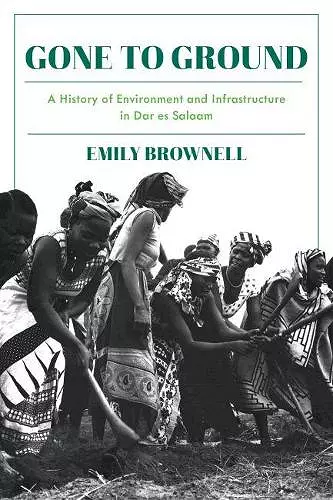Gone to Ground
A History of Environment and Infrastructure in Dar es Salaam
Format:Hardback
Publisher:University of Pittsburgh Press
Published:30th Sep '20
Currently unavailable, our supplier has not provided us a restock date

Gone to Ground is an investigation into the material and political forces that transformed the cityscape of Dar es Salaam, Tanzania in the 1970s and early 1980s. It is both the story of a particular city and the history of a global moment of massive urban transformation from the perspective of those at the center of this shift. Built around an archive of newspapers, oral history interviews, planning documents, and a broad compendium of development reports, Emily Brownell writes about how urbanites navigated the state’s anti-urban planning policies along with the city’s fracturing infrastructures and profound shortages of staple goods to shape Dar’s environment. They did so most frequently by “going to ground” in the urban periphery, orienting their lives to the city’s outskirts where they could plant small farms, find building materials, produce charcoal, and escape the state’s policing of urban space.
Gone to Ground is the story of Dar es Salaam's environment and infrastructure as told through the central tension between the city and the countryside, a recurrent theme that anchors the wide-ranging material in this book and maps it on to broader debates about cities and environmental histories in the Global South and in sub-Saharan Africa in particular. Brownell captures the ways in which the city’s inhabitants constantly brought the rural into the city, in terms of materials, practices, and ways of using the environment. The book brings an avowedly political Third World perspective to the long tradition of work on urban-rural connections in African Studies, insisting that we examine what these things look like on the ground, from a different place." —Claire Mercer, London School of Economics
"Emily Brownell’s Gone to Ground offers a major contribution to the academic literature on Africa’s recent urban history. It marks an important conceptual advance in this field by both theorizing and demonstrating how Dar es Salaam’s population repurposed the material environment of the city and its surroundings in ways that transcend familiar analytical categories. This was done through popular acts of domestication and transformation of an ostensibly universal urban infrastructure that were refitted to local means and practices. Brownell makes a persuasive case that the 1970s and 1980s period was the most decisive in shaping what the city of Dar es Salaam has become today, and does so by rejecting still-dominant normative frames of urban ‘failure’ that typify 1970s-era Africa. She shows instead how urban space and livelihood strategies were reshaped by inventive and unpredictable connection-making between African residents and their built environment." —James Brennan, University of Illinois
ISBN: 9780822946113
Dimensions: unknown
Weight: unknown
278 pages